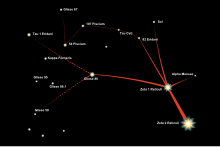https://www.youtube.com/watch?v=Um-boewttOE&t=27s
OR
UFOs Over Pittsburgh EP44 Stanton Friedman and Kathleen Marden PT3of3
Analyzing the star map
In 1968, Marjorie Fish of Oak Harbor, Ohio, read Fuller's Interrupted Journey. She was an elementary school teacher and amateur astronomer. Intrigued by the "star map", Fish wondered if it might be "deciphered" to determine which star system the UFO came from. Assuming that one of the fifteen stars on the map must represent the Earth's Sun, Fish constructed a three-dimensional model of nearby Sun-like stars using thread and beads, basing stellar distances on those published in the 1969 Gliese Star Catalogue. Studying thousands of vantage points over several years, the only one that seemed to match the Hill map was from the viewpoint of the double star system of Zeta Reticuli.
Distance information needed to match three stars, forming the distinctive triangle Hill said she remembered, was not generally available until the 1969 Gliese Catalogue came out.
Fish sent her analysis to Webb. Agreeing with her conclusions, Webb sent the map to Terence Dickinson, editor of the popular magazine Astronomy. Dickinson did not endorse Fish and Webb's conclusions, but for the first time in the journal's history, Astronomy invited comments and debate on a UFO report, starting with an opening article in the December 1974 issue. For about a year afterward, the opinions page of Astronomy carried arguments for and against Fish's star map. Notable was an argument made by Carl Sagan and Steven Soter, arguing that the seeming "star map" was little more than a random alignment of chance points. In contrast, those more favorable to the map, such as David Saunders, a statistician who had been on the Condon UFO study, argued that unusual alignment of key Sun-like stars in a plane centered around Zeta Reticuli (first described by Fish) was statistically improbable to have happened by chance from a random group of stars in our immediate neighborhood.
In 1993, two German crop circle enthusiasts, Joachim Koch and Hans-Jürgen Kyborg, suggested that the map depicted planets in the Solar System, not nearby stars. The objects in the map, they said, closely match the positions of the Sun, the six inner planets and several asteroids around the time of the incident.




No comments:
Post a Comment